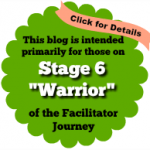Clear Flowing Agendas – Designing Using Meta Methods

What is a meta method?
It is a framework that can be used over and over in many different circumstances. It is the foundation behind all other tools and techniques. It works marvelously in most situations that require clear thinking. Are you designing with meta methods?
I will talk about two in this blog and show how I use them in a typical agenda design. Specifically, I will show you how I insert many other tools and techniques inside these frameworks that keep my design clean and with good flow. Sounds good, no?
META METHOD 1: ORID
ORID is the also known as the Top Focused Conversation method. It is typically used to produce stellar conversations. It is also invaluable in creating the underlying structure or design for your agenda. See how I used it many times in the sample agenda below as a discussion tool, as well as the overall meta design. You can learn about this from the books noted in the resource section below. Training is offered worldwide as well. We generally have classes in Oregon in June and December.
META METHOD 2: DIVERGE CONVERGE
Process facilitators use THIS diverge-converge FRAMEWORK over and over in many different ways. Simply put, it is getting a lot of ideas to a question (diverge) and then finding a way to shorten the list that synthesizes the thinking of the whole group (converge).

Source: Colleague Loh Teck Kwang from Pareto Solutions, Singapore
In this sample design below, we use it once to define the problem and again to solve the problem. Facilitators call this the double diamond diverge-converge approach. Watch for this double diamond approach also in the design. I label them Diverge 1, Converge 1 and Diverge 2, Converge 2.

Source: Colleague Loh Teck Kwang from Pareto Solutions, Singapore
Sample Agenda Using Meta Methods
Overview (5 min)
- Share purpose and timing of this workshop: Prioritizing best practices for reducing tobacco addiction in our regional youth population (2.5 hours)
- Introduce aims, agenda and guiding principles
A. Defining the problem: (1st diamond of Diverge-Converge)
What do we know about it? How would we characterize it in this moment in time and with this particular target population?
ORID suite of activities:
- O- Round Robin discussion: what images/words come to mind when you hear “tobacco addiction”?
- O- Large group sharing: what facts have you heard about tobacco addiction in our regional youth population? (please stick with facts versus interpretation of facts) (7 min)
- R- Small group story telling in triads: what positive stories have you heard about reducing tobacco addiction elsewhere or in this region?
- R- Small group story telling same triads: what challenging stories have you heard about tobacco addiction in youth in this region? Pick up 3-4 positive and negative stories in large group (10 min)
- I- Small group Creation of a 3-D model of problem-Diverge 1: Groups of six (combine 2 triads) compose a metaphoric sculpture of aspects of what the tobacco youth addiction “problem” or challenge is…(7 min)
- D- Gallery Walk: Each group explains their sculpture in 1 minute. Facilitator takes notes as they talk on F/C. (7 min)
- D- Small Group writing and posting – Converge 1: Go back to your group of six and define the problem in one sentence. Write in large font on sheets provided. Post your statement. Compare and lightly merge the 4 statements as best as you can. Ending up with several sentences is also ok. (10 min)
___________________________
- Stand up and stretch (3 min)
B. Exploring Solutions (2nd diamond of Diverge-Converge)
- O- Individual document scanning: On your own, briefly highlight key pages of the tobacco addiction solutions national report recently published. Share things that stood out for you with two others. (7 min)
- R- Individual Guided Visualization: (Diverge 2) Imagine virtually zero tobacco addiction with our regional youth in 5-10 years. What do you see and hear happening? What specific actions have been taken to change this situation? No wrong ideas – anything is helpful. Be Specific. Aim for LOTS of ideas. (5-7 min)
- R/I- Individual innovating- Diverge 2 and Converge 2): Facilitator prompts with proactive questions after 2-3 min. e.g., “I am going to push you to be more creative with your solutions and “ think out of the box” eg., if you were a musician, what solutions would you come up with? A car mechanic? a carpenter? A software engineer? a dancer? a tourism agent?” Star your 3 best ideas. (10 min)
- I- Small group sharing – Converge 2 Quickly share your 3 starred ideas with 3 others. Strive to understand what others are seeing and hearing in this future. Refine into true solution language if needed. Star group’s best 2 ideas (10 min)
- I- Modified Nominal Group Technique – Converge 2. Each group shares 1 different idea. Scribe numbers each idea and writes it down on flip chart in very large print. Go around 1 more time or until all groups have shared their different ideas. Aim for about 10-12 ideas. Discuss less clear ideas so every person understands them. (10 -15 min)
- D- Small group Prioritization – Converge 2. From master list generated by whole group, each small group chooses 5-6 ideas (50% of total) – things that are most catalytic for this moment in history of tobacco addiction in youth. What needs to happen first AND will have biggest positive impact? Submit your group’s 5 choices rank ordered 1-5 on a sheet of paper. Scribe Facilitator tallies onto flip chart table. (10-15 min)
C. Large Group ORID Reflection: Facilitator asks… (5 min)
- O- What do you observe on the chart?
- R- What surprises you?
- I- What would happen if tobacco addiction reduction strategies focused on these as our first solutions. How will it make a difference?
- D- For those who have thoroughly read the national solutions report, what is similar in this report to what you are recommending? What is different?
- D- What shall we be sure to highlight from our discussion?
D. Facilitator Shares Next Steps:
“We will debrief after the break and decide how to communicate this thinking with key implementation and policy people.”
Resources
ToP Facilitation Methods – Click to find a training near you!





